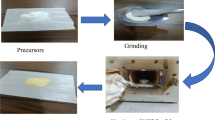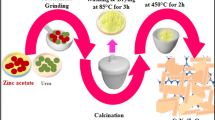Abstract
Photocatalytic reduction of CO2 was carried out on villiform spherical catalysts of Pd-TiO2 in isopropanol solution. The catalysts were synthesized by hydrothermal method, their structures, morphologies and optical absorption properties were characterized by X-ray diffraction (XRD), energy dispersive X-ray spectroscopy (EDS), scanning electron microscopy (SEM), transmission electron microscopy (TEM), high-resolution transmission electron microscopy (HRTEM) and UV-vis absorption spectroscopy (UV-vis). The photocatalytic activities with different loading amounts and morphologies were evaluated for determining the dominant effect and optimizing the catalyst preparation. Based on a villiform spherical TiO2 with the largest specific surface area in our experiments, we prepared a set of catalysts with various loading amounts of palladium and tested them by bubbling CO2 through the slurry of catalyst and isopropanol. The highest formation rate of isopropyl formate was 276.6 μmol/g·cat/h. Eventually we proposed the reaction mechanism.
Similar content being viewed by others
References
Fujishima A. Electrochemical Photolysis of Water at a Semiconductor Electrode[J]. Nature, 1972, 238 (5358): 37–38
Inoue T, Fujishima A, Konishi S, et al. Photoelectrocatalytic Reduction of Carbon Dioxide in Aqueous Suspensions of Semiconductor Powders[J]. Nature, 1979, 277(5698): 637–638
Kasuga T. Formation of Titanium Oxide Nanotubes Using Chemical Treatments and Their Characteristic Properties[J]. Thin Solid Film, 2006, 496(12): 141–145
Gan X Y, Gao X D. TiO2 Nanorod-derived Synthesis of Upstanding Hexagonal Kassite Nanosheet Arrays: an Intermediate Route to Novel Nanoporous TiO2 Nanosheet Arrays[J]. Cryst.Growth Des., 2012, 12(1): 289–296
Xu C K, Paul H Shin. Ordered TiO2 Nanotube Arrays on Transparent Conductive Oxide for Dye-Sensitized Solar Cells[J]. Chem. Mater., 2010, 22(1): 143–148
Hou Y, Li X Y. Photoeletrocatalytic Activity of a Cu2O-Loaded Self-Orgnized Highly Oriented TiO2 Nanotube Array Electrode for 4-Chlorophenol Degradation[J]. Environ.Sci.Technol., 2009, 43(3): 858–863
Seulgi So, K Lee. Ultrafast Growth of Highly Ordered Anodic TiO2 Nanotubes in Lactic Acid Electrolytes[J]. J.Am.Chem.Soc., 2012, 134(28): 11316–11318
Na Lu, Xie Q. Fabrication of Boron-Doped TiO2 Nanotube Array Electrode and Investigation of Its Photoelectrochemical Capability[J]. J.Phys.Chem.C, 2007, 111(8): 11836–11842
Nakahira A, Kubo K. Formation Mechanism of TiO2-Derived Titanate Nanotubes Prepared by the Hydrothermal Process[J]. Inorg. Chem., 2010, 49(13): 5845–5852
Tian B L, Zhang X T. Strong Visible Absorption and Photoluminescence of Titanic Acid Nanotubes by Hydrothermal Method[J]. J.Phys. Chem.C, 2008, 112(14): 5361–5364
Kubo T, Nakahira A. Local Structure of TiO2-Derived Nanotubes Prepared by the Hydrothermal Process[J]. J.Phys.Chem.C, 2008, 112(37): 1658–1662
Sun Z Q, Kim J H. Rational Design of 3D Dendritic TiO2 Nanostructures with Favorable Architectures[J]. J.Am.Chem.Soc., 2008, 133(8): 19314–19317
Debabrata S, Chandan K Ghosh. Three Dimensional Ag2O/TiO2 Type-II(p-n) Nanoheterojunctions for Superior Photocatalytic Activity[J]. Acs.Appl.Mater.Interfaces, 2013, 5(2): 331–337
Liu B, Eray S Aydil. Growth of Oriented Single-Crystalline Rutile TiO Nanorods on Transparent Conducting Substrates for Dye-Sensitized Solar cells[J]. J.Am.Chem.Soc., 2009, 131(18): 3985–3990
Hirano K, Inoue K, Yatsu T. Photocatalysed Reduction of CO2 in Aqueous TiO2 Suspension Mixed with Copper Powder[J]. J.Photochem. Photobil.A:Chem., 1992, 64(2): 255–258
Acknowledgements
We gratefully acknowledge financial support by the National Natural Science Foundation of China (NSFC) (No. 21176192 and 21776220), the Tianjin Natural Science Foundation (No. 12JCZDJC29400), and Training Project of Innovation Team of Colleges and Universities in Tianjin (No.TD13-5020).
Author information
Authors and Affiliations
Corresponding author
Additional information
Funded by the National Natural Science Foundation of China (No. 21176192 and 21776220)
Rights and permissions
About this article
Cite this article
Shao, X., Yin, X., Wang, B. et al. Hydrothermally Synthesizing Nanospheres of Pd Loaded TiO2 for Photocatalytically Reducing CO2 in Isopropanol to Isopropyl Formate. J. Wuhan Univ. Technol.-Mat. Sci. Edit. 33, 1046–1050 (2018). https://doi.org/10.1007/s11595-018-1932-7
Received:
Accepted:
Published:
Issue Date:
DOI: https://doi.org/10.1007/s11595-018-1932-7




